BSBMGT615: Contribute to Organisation Development
VerifiedAdded on 2021/06/15
|9
|2015
|75
AI Summary
Contribute Materials
Your contribution can guide someone’s learning journey. Share your
documents today.
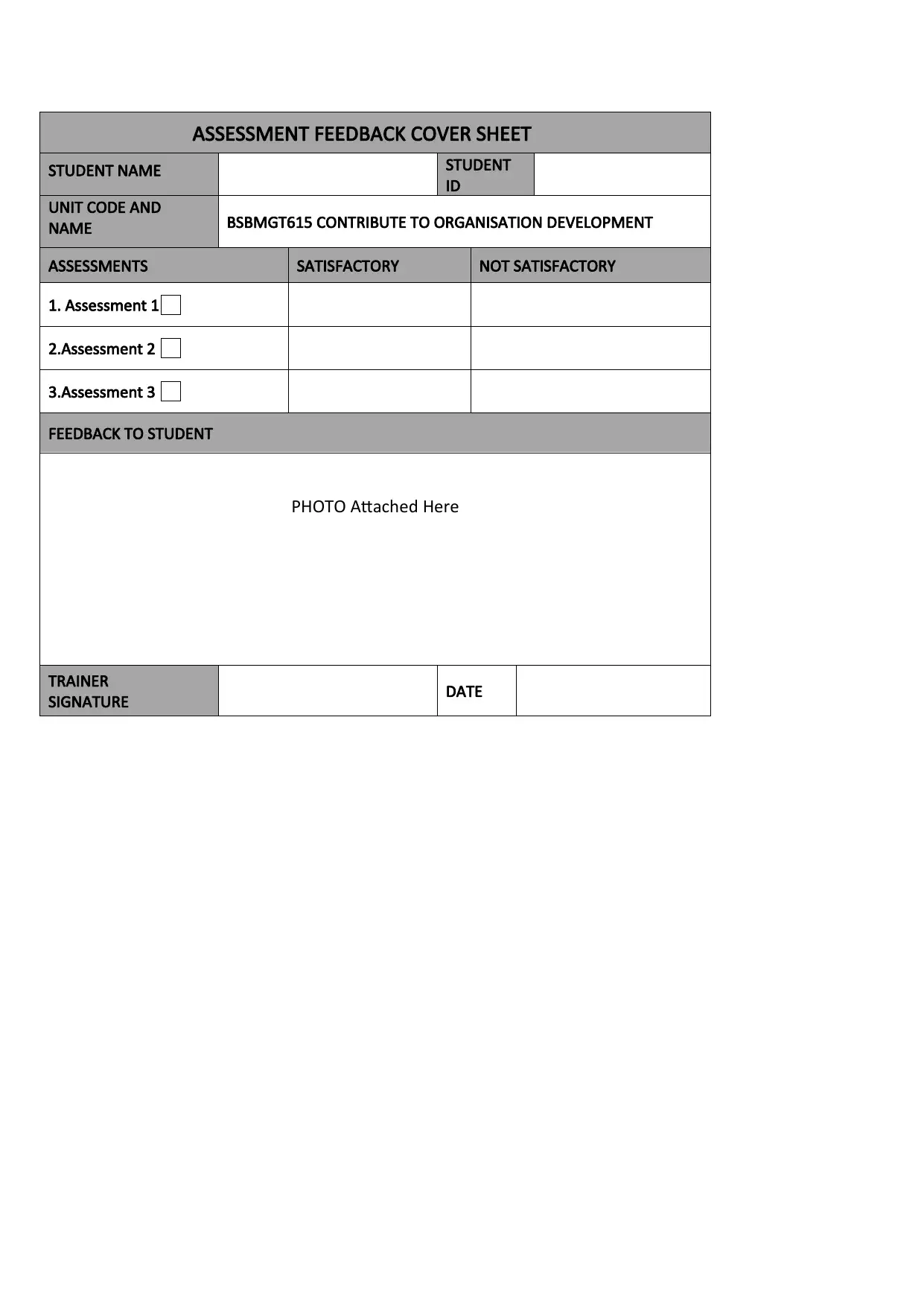
ASSESSMENT FEEDBACK COVER SHEET
STUDENT NAME STUDENT
ID
UNIT CODE AND
NAME BSBMGT615 CONTRIBUTE TO ORGANISATION DEVELOPMENT
ASSESSMENTS SATISFACTORY NOT SATISFACTORY
1. Assessment 1
2.Assessment 2
3.Assessment 3
FEEDBACK TO STUDENT
PHOTO Attached Here
TRAINER
SIGNATURE DATE
STUDENT NAME STUDENT
ID
UNIT CODE AND
NAME BSBMGT615 CONTRIBUTE TO ORGANISATION DEVELOPMENT
ASSESSMENTS SATISFACTORY NOT SATISFACTORY
1. Assessment 1
2.Assessment 2
3.Assessment 3
FEEDBACK TO STUDENT
PHOTO Attached Here
TRAINER
SIGNATURE DATE
Secure Best Marks with AI Grader
Need help grading? Try our AI Grader for instant feedback on your assignments.
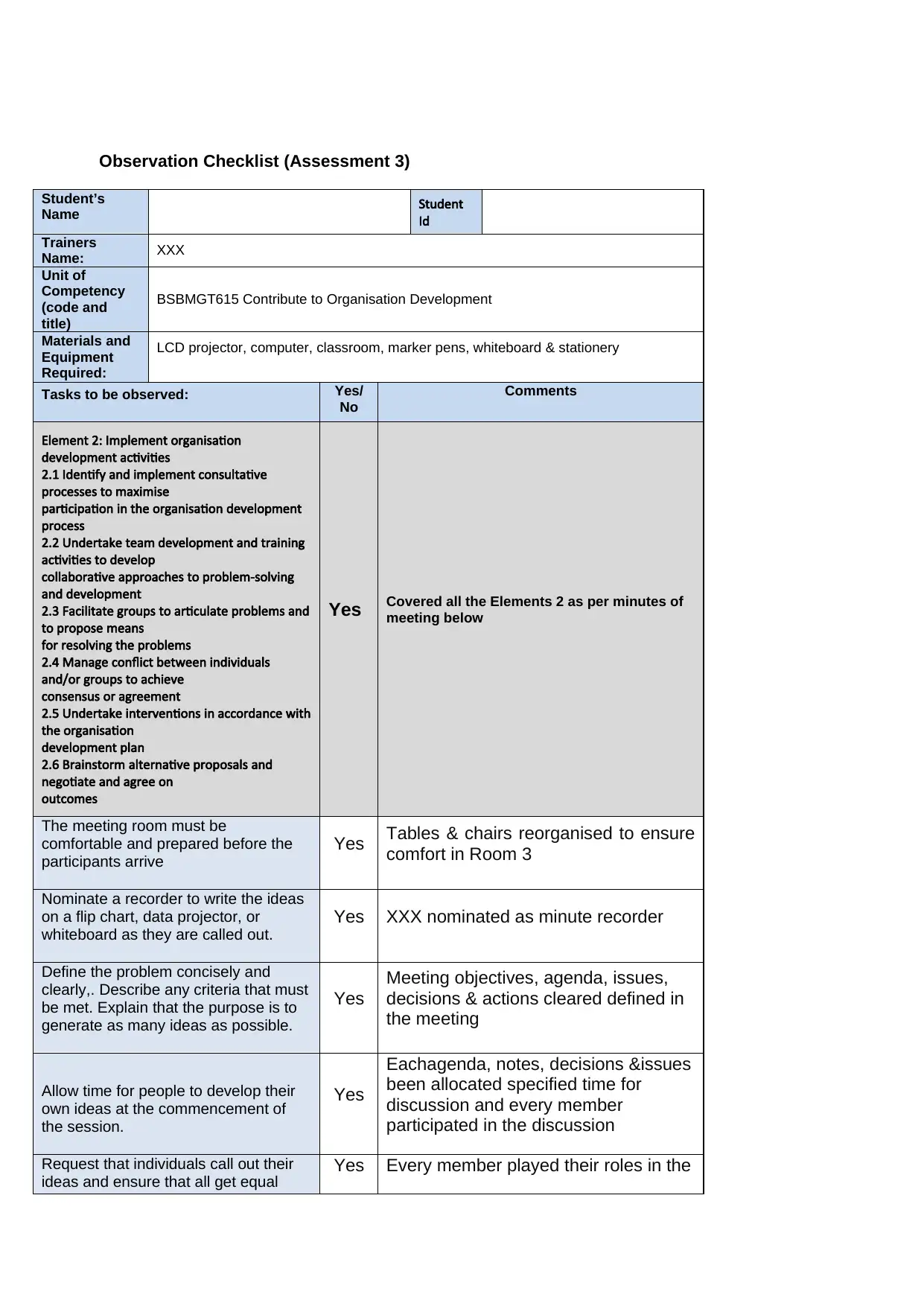
Observation Checklist (Assessment 3)
Student’s
Name Student
Id
Trainers
Name: XXX
Unit of
Competency
(code and
title)
BSBMGT615 Contribute to Organisation Development
Materials and
Equipment
Required:
LCD projector, computer, classroom, marker pens, whiteboard & stationery
Tasks to be observed: Yes/
No
Comments
Element 2: Implement organisation
development activities
2.1 Identify and implement consultative
processes to maximise
participation in the organisation development
process
2.2 Undertake team development and training
activities to develop
collaborative approaches to problem-solving
and development
2.3 Facilitate groups to articulate problems and
to propose means
for resolving the problems
2.4 Manage conflict between individuals
and/or groups to achieve
consensus or agreement
2.5 Undertake interventions in accordance with
the organisation
development plan
2.6 Brainstorm alternative proposals and
negotiate and agree on
outcomes
Yes Covered all the Elements 2 as per minutes of
meeting below
The meeting room must be
comfortable and prepared before the
participants arrive
Yes Tables & chairs reorganised to ensure
comfort in Room 3
Nominate a recorder to write the ideas
on a flip chart, data projector, or
whiteboard as they are called out.
Yes XXX nominated as minute recorder
Define the problem concisely and
clearly,. Describe any criteria that must
be met. Explain that the purpose is to
generate as many ideas as possible.
Yes
Meeting objectives, agenda, issues,
decisions & actions cleared defined in
the meeting
Allow time for people to develop their
own ideas at the commencement of
the session.
Yes
Eachagenda, notes, decisions &issues
been allocated specified time for
discussion and every member
participated in the discussion
Request that individuals call out their
ideas and ensure that all get equal
Yes Every member played their roles in the
Student’s
Name Student
Id
Trainers
Name: XXX
Unit of
Competency
(code and
title)
BSBMGT615 Contribute to Organisation Development
Materials and
Equipment
Required:
LCD projector, computer, classroom, marker pens, whiteboard & stationery
Tasks to be observed: Yes/
No
Comments
Element 2: Implement organisation
development activities
2.1 Identify and implement consultative
processes to maximise
participation in the organisation development
process
2.2 Undertake team development and training
activities to develop
collaborative approaches to problem-solving
and development
2.3 Facilitate groups to articulate problems and
to propose means
for resolving the problems
2.4 Manage conflict between individuals
and/or groups to achieve
consensus or agreement
2.5 Undertake interventions in accordance with
the organisation
development plan
2.6 Brainstorm alternative proposals and
negotiate and agree on
outcomes
Yes Covered all the Elements 2 as per minutes of
meeting below
The meeting room must be
comfortable and prepared before the
participants arrive
Yes Tables & chairs reorganised to ensure
comfort in Room 3
Nominate a recorder to write the ideas
on a flip chart, data projector, or
whiteboard as they are called out.
Yes XXX nominated as minute recorder
Define the problem concisely and
clearly,. Describe any criteria that must
be met. Explain that the purpose is to
generate as many ideas as possible.
Yes
Meeting objectives, agenda, issues,
decisions & actions cleared defined in
the meeting
Allow time for people to develop their
own ideas at the commencement of
the session.
Yes
Eachagenda, notes, decisions &issues
been allocated specified time for
discussion and every member
participated in the discussion
Request that individuals call out their
ideas and ensure that all get equal
Yes Every member played their roles in the
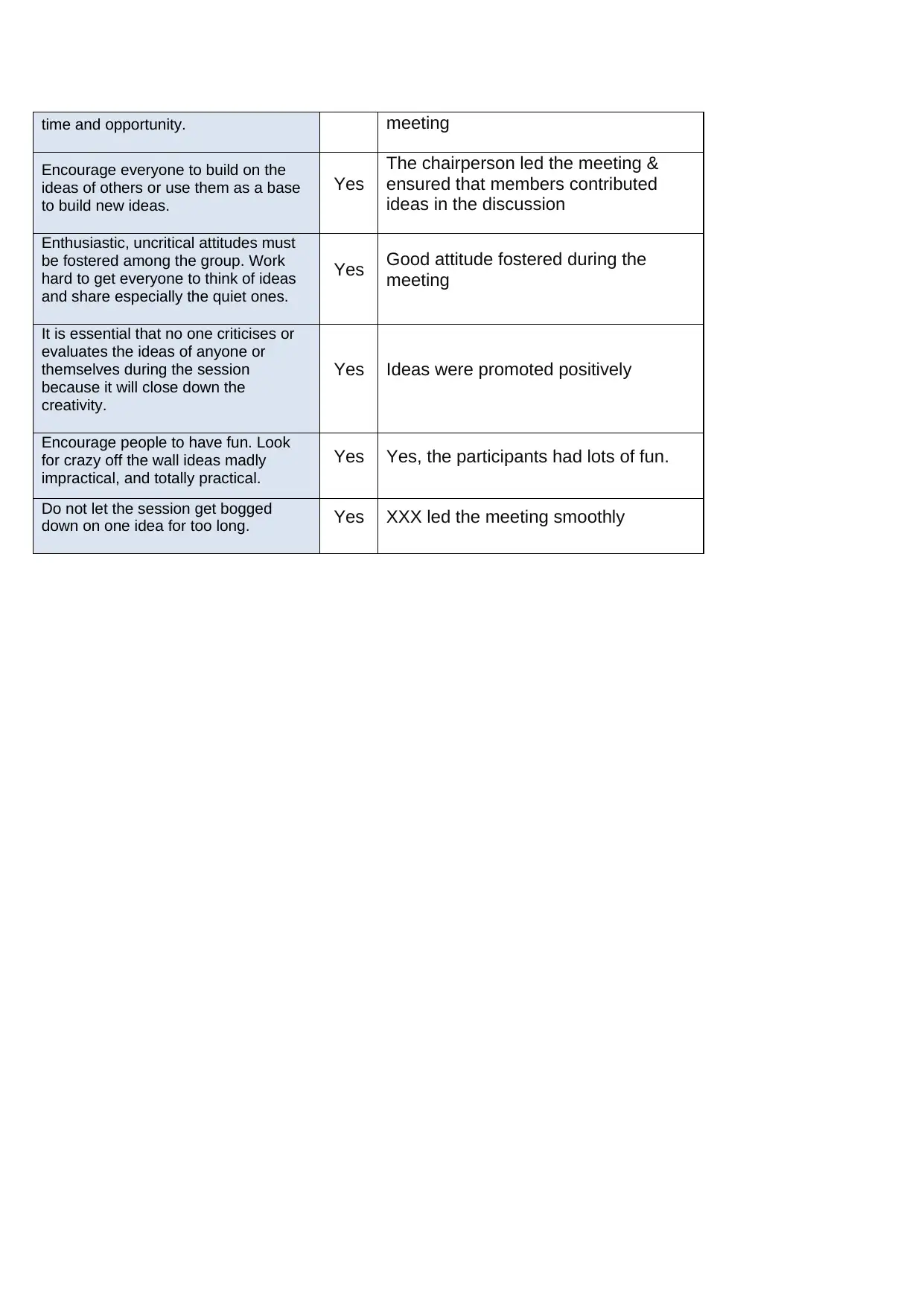
time and opportunity. meeting
Encourage everyone to build on the
ideas of others or use them as a base
to build new ideas.
Yes
The chairperson led the meeting &
ensured that members contributed
ideas in the discussion
Enthusiastic, uncritical attitudes must
be fostered among the group. Work
hard to get everyone to think of ideas
and share especially the quiet ones.
Yes Good attitude fostered during the
meeting
It is essential that no one criticises or
evaluates the ideas of anyone or
themselves during the session
because it will close down the
creativity.
Yes Ideas were promoted positively
Encourage people to have fun. Look
for crazy off the wall ideas madly
impractical, and totally practical.
Yes Yes, the participants had lots of fun.
Do not let the session get bogged
down on one idea for too long. Yes XXX led the meeting smoothly
Encourage everyone to build on the
ideas of others or use them as a base
to build new ideas.
Yes
The chairperson led the meeting &
ensured that members contributed
ideas in the discussion
Enthusiastic, uncritical attitudes must
be fostered among the group. Work
hard to get everyone to think of ideas
and share especially the quiet ones.
Yes Good attitude fostered during the
meeting
It is essential that no one criticises or
evaluates the ideas of anyone or
themselves during the session
because it will close down the
creativity.
Yes Ideas were promoted positively
Encourage people to have fun. Look
for crazy off the wall ideas madly
impractical, and totally practical.
Yes Yes, the participants had lots of fun.
Do not let the session get bogged
down on one idea for too long. Yes XXX led the meeting smoothly
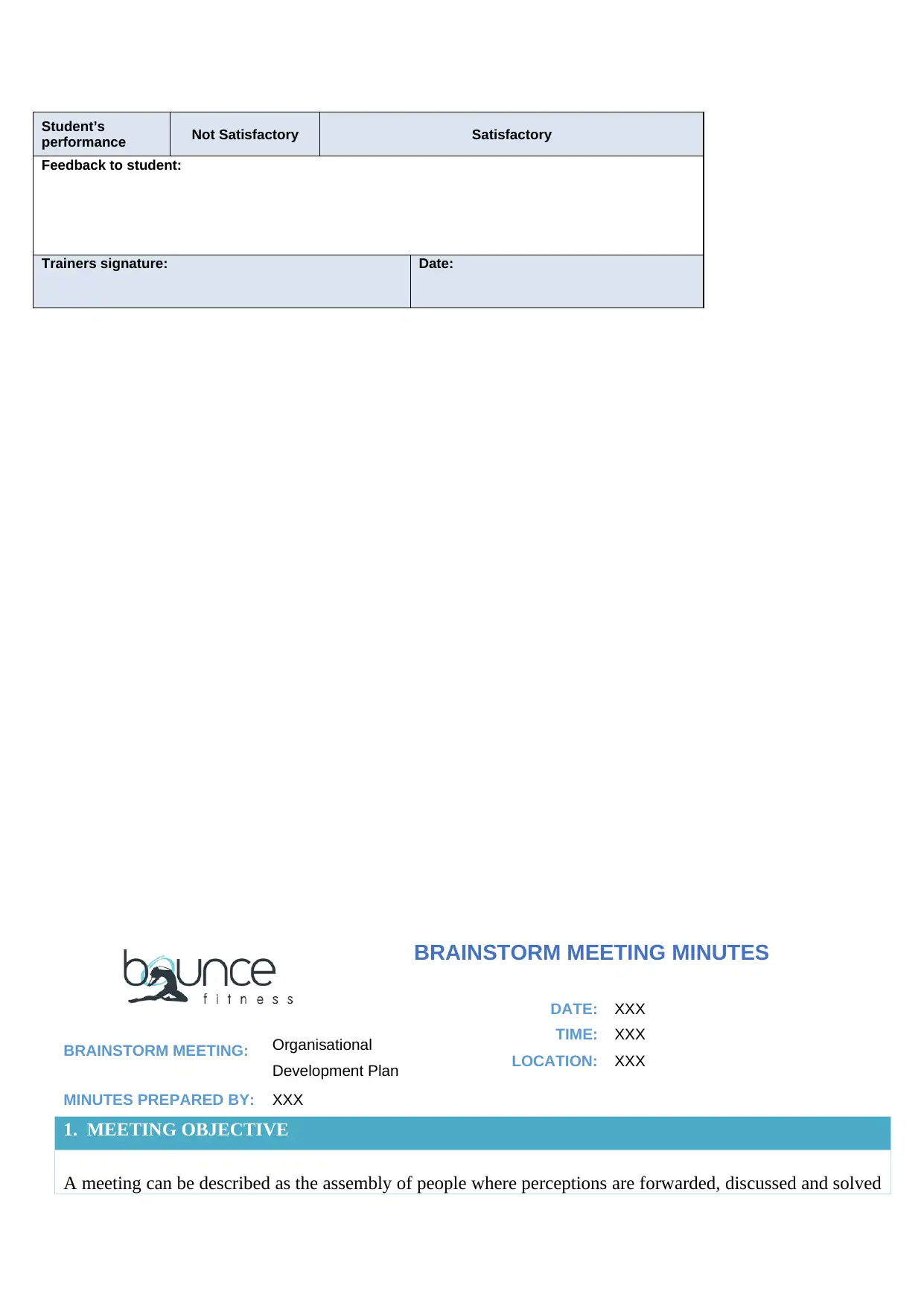
Student’s
performance Not Satisfactory Satisfactory
Feedback to student:
Trainers signature: Date:
BRAINSTORM MEETING MINUTES
BRAINSTORM MEETING: Organisational
Development Plan
MINUTES PREPARED BY: XXX
1. MEETING OBJECTIVE
A meeting can be described as the assembly of people where perceptions are forwarded, discussed and solved
DATE: XXX
TIME: XXX
LOCATION: XXX
performance Not Satisfactory Satisfactory
Feedback to student:
Trainers signature: Date:
BRAINSTORM MEETING MINUTES
BRAINSTORM MEETING: Organisational
Development Plan
MINUTES PREPARED BY: XXX
1. MEETING OBJECTIVE
A meeting can be described as the assembly of people where perceptions are forwarded, discussed and solved
DATE: XXX
TIME: XXX
LOCATION: XXX
Secure Best Marks with AI Grader
Need help grading? Try our AI Grader for instant feedback on your assignments.
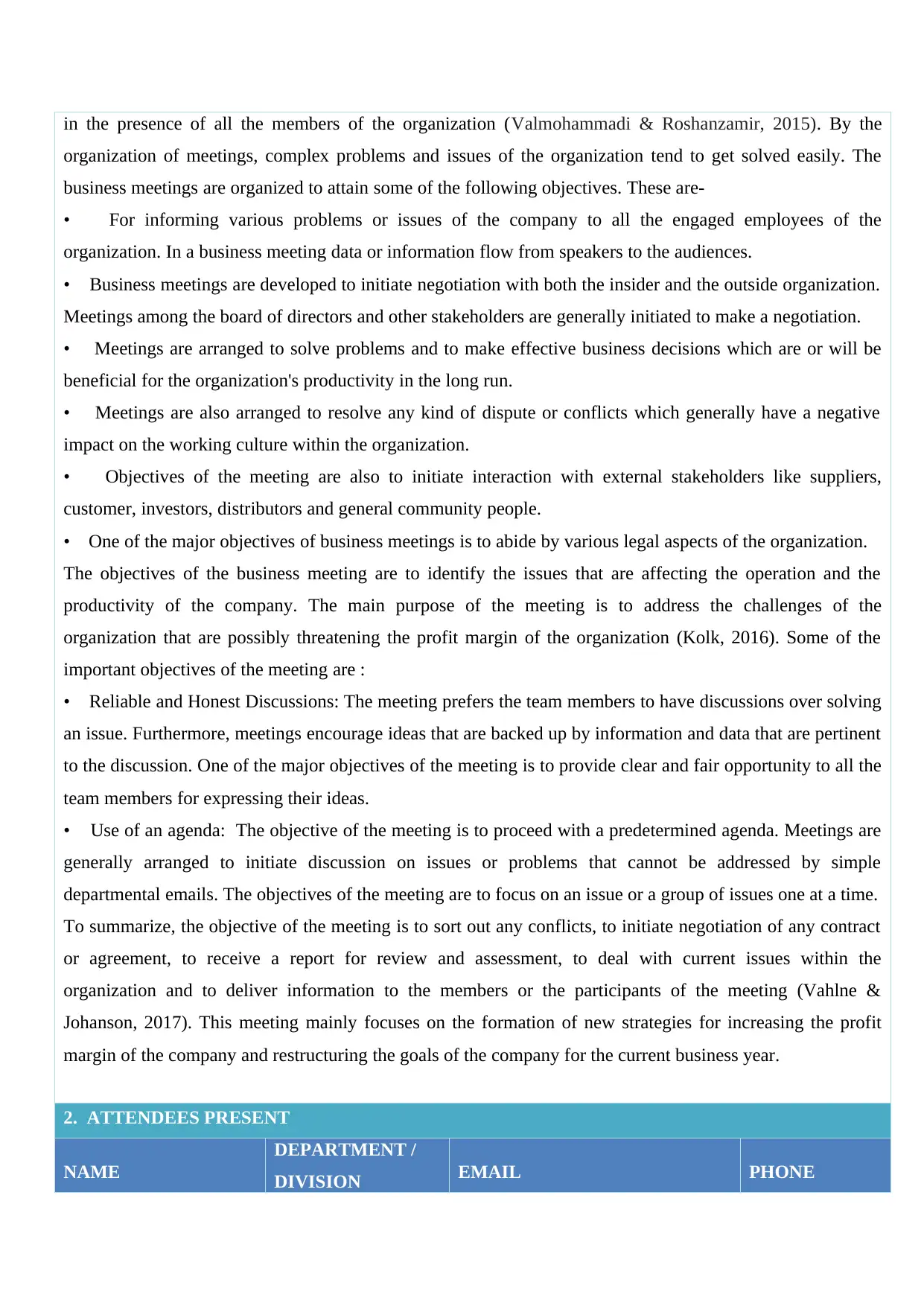
in the presence of all the members of the organization (Valmohammadi & Roshanzamir, 2015). By the
organization of meetings, complex problems and issues of the organization tend to get solved easily. The
business meetings are organized to attain some of the following objectives. These are-
• For informing various problems or issues of the company to all the engaged employees of the
organization. In a business meeting data or information flow from speakers to the audiences.
• Business meetings are developed to initiate negotiation with both the insider and the outside organization.
Meetings among the board of directors and other stakeholders are generally initiated to make a negotiation.
• Meetings are arranged to solve problems and to make effective business decisions which are or will be
beneficial for the organization's productivity in the long run.
• Meetings are also arranged to resolve any kind of dispute or conflicts which generally have a negative
impact on the working culture within the organization.
• Objectives of the meeting are also to initiate interaction with external stakeholders like suppliers,
customer, investors, distributors and general community people.
• One of the major objectives of business meetings is to abide by various legal aspects of the organization.
The objectives of the business meeting are to identify the issues that are affecting the operation and the
productivity of the company. The main purpose of the meeting is to address the challenges of the
organization that are possibly threatening the profit margin of the organization (Kolk, 2016). Some of the
important objectives of the meeting are :
• Reliable and Honest Discussions: The meeting prefers the team members to have discussions over solving
an issue. Furthermore, meetings encourage ideas that are backed up by information and data that are pertinent
to the discussion. One of the major objectives of the meeting is to provide clear and fair opportunity to all the
team members for expressing their ideas.
• Use of an agenda: The objective of the meeting is to proceed with a predetermined agenda. Meetings are
generally arranged to initiate discussion on issues or problems that cannot be addressed by simple
departmental emails. The objectives of the meeting are to focus on an issue or a group of issues one at a time.
To summarize, the objective of the meeting is to sort out any conflicts, to initiate negotiation of any contract
or agreement, to receive a report for review and assessment, to deal with current issues within the
organization and to deliver information to the members or the participants of the meeting (Vahlne &
Johanson, 2017). This meeting mainly focuses on the formation of new strategies for increasing the profit
margin of the company and restructuring the goals of the company for the current business year.
2. ATTENDEES PRESENT
NAME
DEPARTMENT /
DIVISION EMAIL PHONE
organization of meetings, complex problems and issues of the organization tend to get solved easily. The
business meetings are organized to attain some of the following objectives. These are-
• For informing various problems or issues of the company to all the engaged employees of the
organization. In a business meeting data or information flow from speakers to the audiences.
• Business meetings are developed to initiate negotiation with both the insider and the outside organization.
Meetings among the board of directors and other stakeholders are generally initiated to make a negotiation.
• Meetings are arranged to solve problems and to make effective business decisions which are or will be
beneficial for the organization's productivity in the long run.
• Meetings are also arranged to resolve any kind of dispute or conflicts which generally have a negative
impact on the working culture within the organization.
• Objectives of the meeting are also to initiate interaction with external stakeholders like suppliers,
customer, investors, distributors and general community people.
• One of the major objectives of business meetings is to abide by various legal aspects of the organization.
The objectives of the business meeting are to identify the issues that are affecting the operation and the
productivity of the company. The main purpose of the meeting is to address the challenges of the
organization that are possibly threatening the profit margin of the organization (Kolk, 2016). Some of the
important objectives of the meeting are :
• Reliable and Honest Discussions: The meeting prefers the team members to have discussions over solving
an issue. Furthermore, meetings encourage ideas that are backed up by information and data that are pertinent
to the discussion. One of the major objectives of the meeting is to provide clear and fair opportunity to all the
team members for expressing their ideas.
• Use of an agenda: The objective of the meeting is to proceed with a predetermined agenda. Meetings are
generally arranged to initiate discussion on issues or problems that cannot be addressed by simple
departmental emails. The objectives of the meeting are to focus on an issue or a group of issues one at a time.
To summarize, the objective of the meeting is to sort out any conflicts, to initiate negotiation of any contract
or agreement, to receive a report for review and assessment, to deal with current issues within the
organization and to deliver information to the members or the participants of the meeting (Vahlne &
Johanson, 2017). This meeting mainly focuses on the formation of new strategies for increasing the profit
margin of the company and restructuring the goals of the company for the current business year.
2. ATTENDEES PRESENT
NAME
DEPARTMENT /
DIVISION EMAIL PHONE
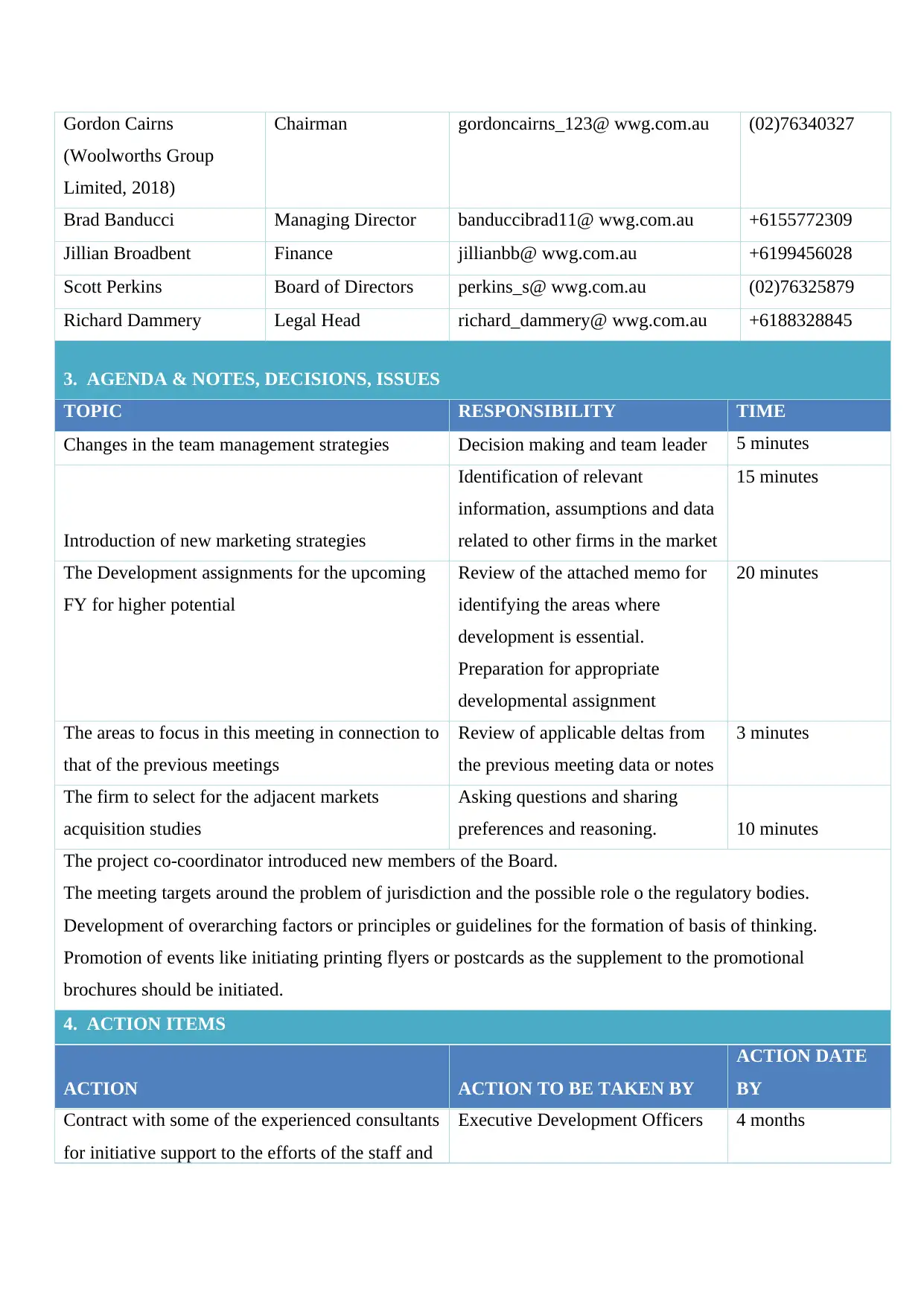
Gordon Cairns
(Woolworths Group
Limited, 2018)
Chairman gordoncairns_123@ wwg.com.au (02)76340327
Brad Banducci Managing Director banduccibrad11@ wwg.com.au +6155772309
Jillian Broadbent Finance jillianbb@ wwg.com.au +6199456028
Scott Perkins Board of Directors perkins_s@ wwg.com.au (02)76325879
Richard Dammery Legal Head richard_dammery@ wwg.com.au +6188328845
3. AGENDA & NOTES, DECISIONS, ISSUES
TOPIC RESPONSIBILITY TIME
Changes in the team management strategies Decision making and team leader 5 minutes
Introduction of new marketing strategies
Identification of relevant
information, assumptions and data
related to other firms in the market
15 minutes
The Development assignments for the upcoming
FY for higher potential
Review of the attached memo for
identifying the areas where
development is essential.
Preparation for appropriate
developmental assignment
20 minutes
The areas to focus in this meeting in connection to
that of the previous meetings
Review of applicable deltas from
the previous meeting data or notes
3 minutes
The firm to select for the adjacent markets
acquisition studies
Asking questions and sharing
preferences and reasoning. 10 minutes
The project co-coordinator introduced new members of the Board.
The meeting targets around the problem of jurisdiction and the possible role o the regulatory bodies.
Development of overarching factors or principles or guidelines for the formation of basis of thinking.
Promotion of events like initiating printing flyers or postcards as the supplement to the promotional
brochures should be initiated.
4. ACTION ITEMS
ACTION ACTION TO BE TAKEN BY
ACTION DATE
BY
Contract with some of the experienced consultants
for initiative support to the efforts of the staff and
Executive Development Officers 4 months
(Woolworths Group
Limited, 2018)
Chairman gordoncairns_123@ wwg.com.au (02)76340327
Brad Banducci Managing Director banduccibrad11@ wwg.com.au +6155772309
Jillian Broadbent Finance jillianbb@ wwg.com.au +6199456028
Scott Perkins Board of Directors perkins_s@ wwg.com.au (02)76325879
Richard Dammery Legal Head richard_dammery@ wwg.com.au +6188328845
3. AGENDA & NOTES, DECISIONS, ISSUES
TOPIC RESPONSIBILITY TIME
Changes in the team management strategies Decision making and team leader 5 minutes
Introduction of new marketing strategies
Identification of relevant
information, assumptions and data
related to other firms in the market
15 minutes
The Development assignments for the upcoming
FY for higher potential
Review of the attached memo for
identifying the areas where
development is essential.
Preparation for appropriate
developmental assignment
20 minutes
The areas to focus in this meeting in connection to
that of the previous meetings
Review of applicable deltas from
the previous meeting data or notes
3 minutes
The firm to select for the adjacent markets
acquisition studies
Asking questions and sharing
preferences and reasoning. 10 minutes
The project co-coordinator introduced new members of the Board.
The meeting targets around the problem of jurisdiction and the possible role o the regulatory bodies.
Development of overarching factors or principles or guidelines for the formation of basis of thinking.
Promotion of events like initiating printing flyers or postcards as the supplement to the promotional
brochures should be initiated.
4. ACTION ITEMS
ACTION ACTION TO BE TAKEN BY
ACTION DATE
BY
Contract with some of the experienced consultants
for initiative support to the efforts of the staff and
Executive Development Officers 4 months
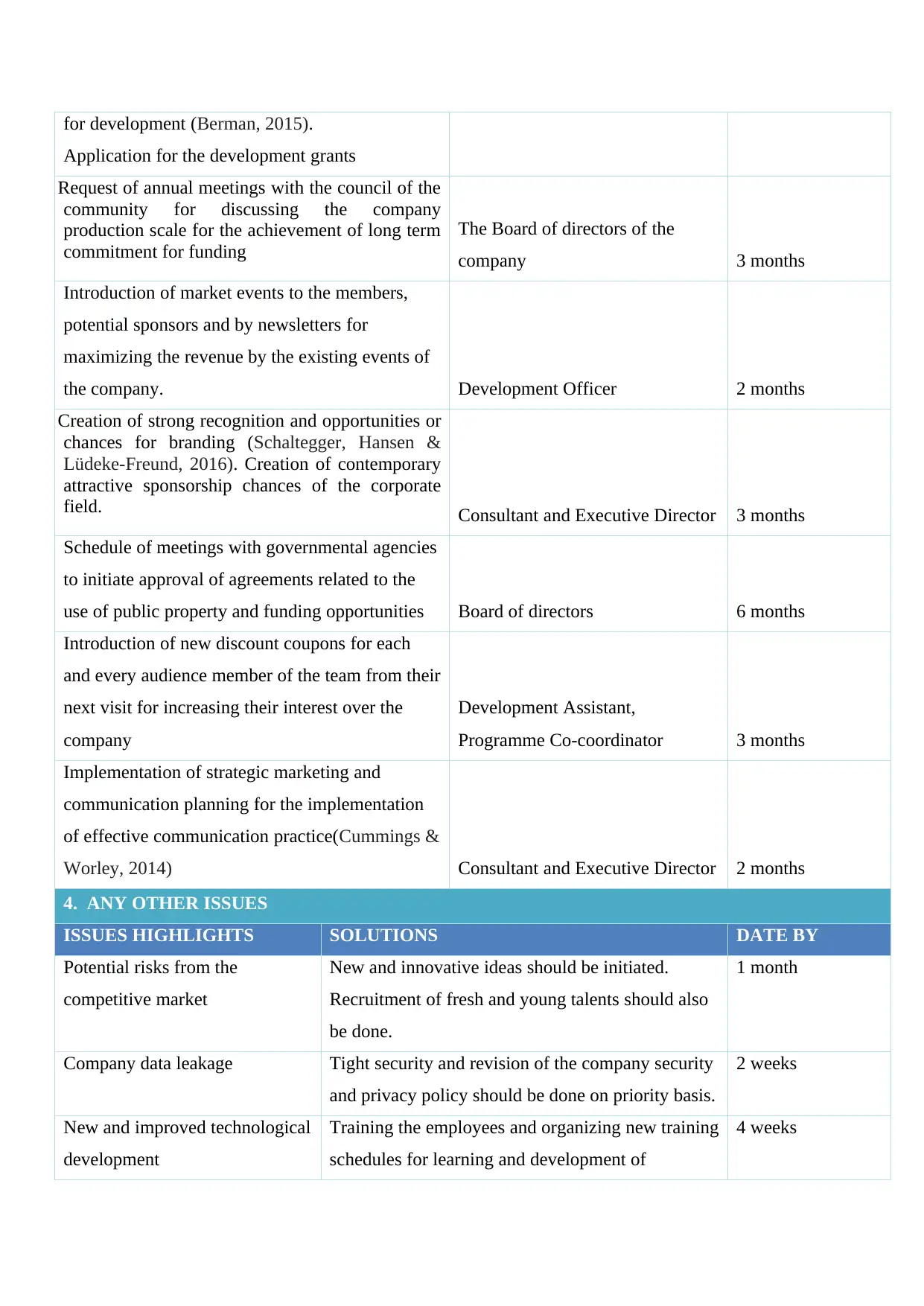
for development (Berman, 2015).
Application for the development grants
Request of annual meetings with the council of the
community for discussing the company
production scale for the achievement of long term
commitment for funding
The Board of directors of the
company 3 months
Introduction of market events to the members,
potential sponsors and by newsletters for
maximizing the revenue by the existing events of
the company. Development Officer 2 months
Creation of strong recognition and opportunities or
chances for branding (Schaltegger, Hansen &
Lüdeke-Freund, 2016). Creation of contemporary
attractive sponsorship chances of the corporate
field. Consultant and Executive Director 3 months
Schedule of meetings with governmental agencies
to initiate approval of agreements related to the
use of public property and funding opportunities Board of directors 6 months
Introduction of new discount coupons for each
and every audience member of the team from their
next visit for increasing their interest over the
company
Development Assistant,
Programme Co-coordinator 3 months
Implementation of strategic marketing and
communication planning for the implementation
of effective communication practice(Cummings &
Worley, 2014) Consultant and Executive Director 2 months
4. ANY OTHER ISSUES
ISSUES HIGHLIGHTS SOLUTIONS DATE BY
Potential risks from the
competitive market
New and innovative ideas should be initiated.
Recruitment of fresh and young talents should also
be done.
1 month
Company data leakage Tight security and revision of the company security
and privacy policy should be done on priority basis.
2 weeks
New and improved technological
development
Training the employees and organizing new training
schedules for learning and development of
4 weeks
Application for the development grants
Request of annual meetings with the council of the
community for discussing the company
production scale for the achievement of long term
commitment for funding
The Board of directors of the
company 3 months
Introduction of market events to the members,
potential sponsors and by newsletters for
maximizing the revenue by the existing events of
the company. Development Officer 2 months
Creation of strong recognition and opportunities or
chances for branding (Schaltegger, Hansen &
Lüdeke-Freund, 2016). Creation of contemporary
attractive sponsorship chances of the corporate
field. Consultant and Executive Director 3 months
Schedule of meetings with governmental agencies
to initiate approval of agreements related to the
use of public property and funding opportunities Board of directors 6 months
Introduction of new discount coupons for each
and every audience member of the team from their
next visit for increasing their interest over the
company
Development Assistant,
Programme Co-coordinator 3 months
Implementation of strategic marketing and
communication planning for the implementation
of effective communication practice(Cummings &
Worley, 2014) Consultant and Executive Director 2 months
4. ANY OTHER ISSUES
ISSUES HIGHLIGHTS SOLUTIONS DATE BY
Potential risks from the
competitive market
New and innovative ideas should be initiated.
Recruitment of fresh and young talents should also
be done.
1 month
Company data leakage Tight security and revision of the company security
and privacy policy should be done on priority basis.
2 weeks
New and improved technological
development
Training the employees and organizing new training
schedules for learning and development of
4 weeks
Paraphrase This Document
Need a fresh take? Get an instant paraphrase of this document with our AI Paraphraser

professional skills should be done.
5. NEXT MEETING (if applicable)
DATE 13 December 2018 TIME 16.13 LOCATION Australia
OBJECTIVE Organizational Improvement and development in the productivity scale
SUBMITTED
BY:
XXX (Minute keeper) APPROVED
BY:
XXX
5. NEXT MEETING (if applicable)
DATE 13 December 2018 TIME 16.13 LOCATION Australia
OBJECTIVE Organizational Improvement and development in the productivity scale
SUBMITTED
BY:
XXX (Minute keeper) APPROVED
BY:
XXX
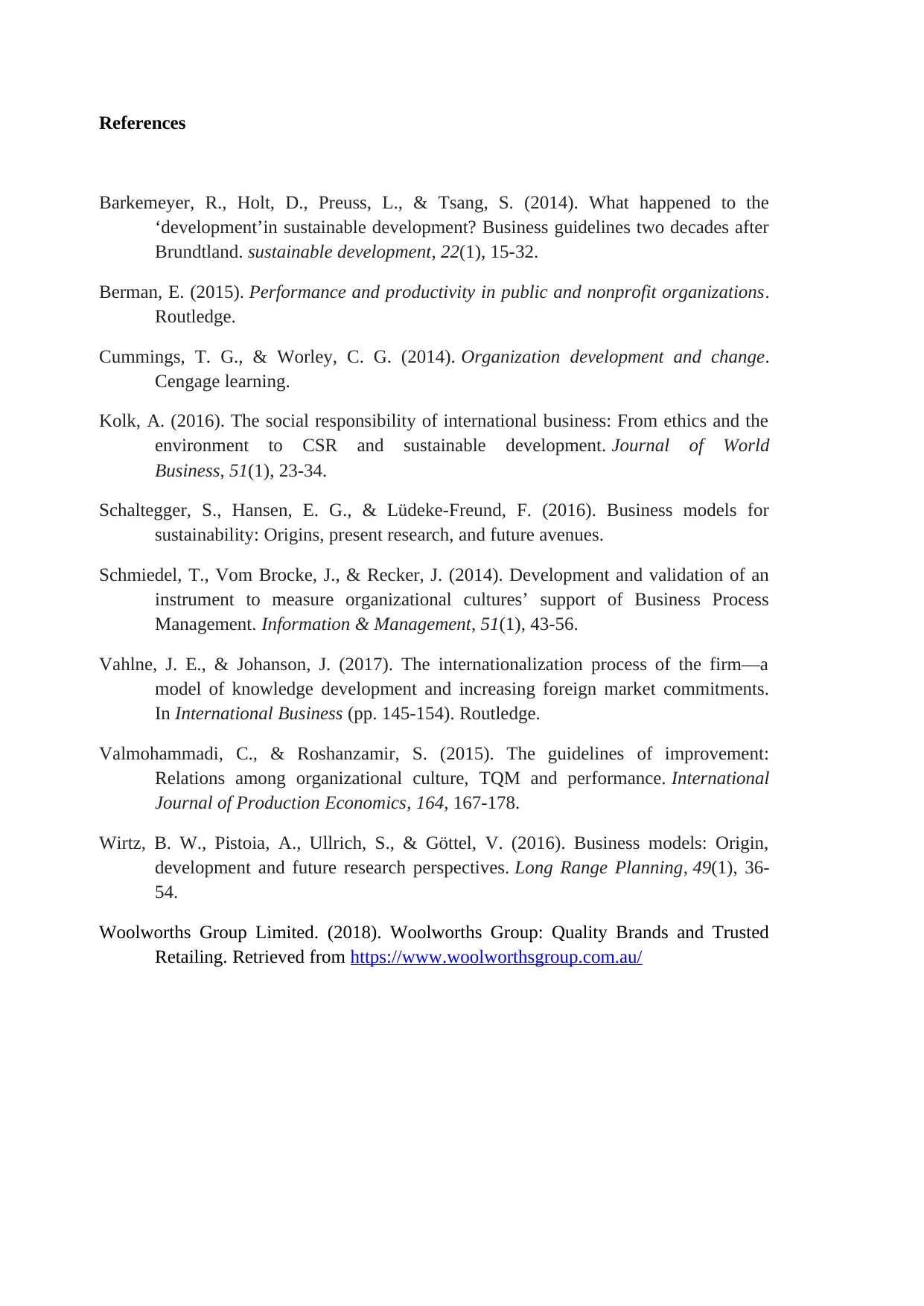
References
Barkemeyer, R., Holt, D., Preuss, L., & Tsang, S. (2014). What happened to the
‘development’in sustainable development? Business guidelines two decades after
Brundtland. sustainable development, 22(1), 15-32.
Berman, E. (2015). Performance and productivity in public and nonprofit organizations.
Routledge.
Cummings, T. G., & Worley, C. G. (2014). Organization development and change.
Cengage learning.
Kolk, A. (2016). The social responsibility of international business: From ethics and the
environment to CSR and sustainable development. Journal of World
Business, 51(1), 23-34.
Schaltegger, S., Hansen, E. G., & Lüdeke-Freund, F. (2016). Business models for
sustainability: Origins, present research, and future avenues.
Schmiedel, T., Vom Brocke, J., & Recker, J. (2014). Development and validation of an
instrument to measure organizational cultures’ support of Business Process
Management. Information & Management, 51(1), 43-56.
Vahlne, J. E., & Johanson, J. (2017). The internationalization process of the firm—a
model of knowledge development and increasing foreign market commitments.
In International Business (pp. 145-154). Routledge.
Valmohammadi, C., & Roshanzamir, S. (2015). The guidelines of improvement:
Relations among organizational culture, TQM and performance. International
Journal of Production Economics, 164, 167-178.
Wirtz, B. W., Pistoia, A., Ullrich, S., & Göttel, V. (2016). Business models: Origin,
development and future research perspectives. Long Range Planning, 49(1), 36-
54.
Woolworths Group Limited. (2018). Woolworths Group: Quality Brands and Trusted
Retailing. Retrieved from https://www.woolworthsgroup.com.au/
Barkemeyer, R., Holt, D., Preuss, L., & Tsang, S. (2014). What happened to the
‘development’in sustainable development? Business guidelines two decades after
Brundtland. sustainable development, 22(1), 15-32.
Berman, E. (2015). Performance and productivity in public and nonprofit organizations.
Routledge.
Cummings, T. G., & Worley, C. G. (2014). Organization development and change.
Cengage learning.
Kolk, A. (2016). The social responsibility of international business: From ethics and the
environment to CSR and sustainable development. Journal of World
Business, 51(1), 23-34.
Schaltegger, S., Hansen, E. G., & Lüdeke-Freund, F. (2016). Business models for
sustainability: Origins, present research, and future avenues.
Schmiedel, T., Vom Brocke, J., & Recker, J. (2014). Development and validation of an
instrument to measure organizational cultures’ support of Business Process
Management. Information & Management, 51(1), 43-56.
Vahlne, J. E., & Johanson, J. (2017). The internationalization process of the firm—a
model of knowledge development and increasing foreign market commitments.
In International Business (pp. 145-154). Routledge.
Valmohammadi, C., & Roshanzamir, S. (2015). The guidelines of improvement:
Relations among organizational culture, TQM and performance. International
Journal of Production Economics, 164, 167-178.
Wirtz, B. W., Pistoia, A., Ullrich, S., & Göttel, V. (2016). Business models: Origin,
development and future research perspectives. Long Range Planning, 49(1), 36-
54.
Woolworths Group Limited. (2018). Woolworths Group: Quality Brands and Trusted
Retailing. Retrieved from https://www.woolworthsgroup.com.au/
1 out of 9
Your All-in-One AI-Powered Toolkit for Academic Success.
+13062052269
info@desklib.com
Available 24*7 on WhatsApp / Email
![[object Object]](/_next/static/media/star-bottom.7253800d.svg)
Unlock your academic potential
© 2024 | Zucol Services PVT LTD | All rights reserved.
